Analysis of Aboriginals in Nursing Curriculum and Empathy Gaps
VerifiedAdded on 2022/10/10
|6
|1529
|361
Essay
AI Summary
This essay delves into the critical intersection of Aboriginal health and the nursing curriculum, focusing on the identification of empathy gaps and the exploration of effective communication strategies. It begins by defining and analyzing the concept of empathy gaps, particularly in the context of healthcare, and how they can manifest in interactions with Aboriginal patients. The essay examines the impact of these gaps on patient care, highlighting the potential for misinterpretations, biases, and ultimately, a compromised quality of care. Furthermore, the essay proceeds to identify and evaluate various communication strategies that can be employed to better understand the perspectives of Aboriginal individuals, including active listening, empathetic language, and culturally sensitive approaches. The essay uses a case study to illustrate these concepts and emphasizes the importance of cultural safety and respect in nursing practice. The essay concludes by stressing the need for nurses to be aware of their own biases and to actively work towards providing non-judgmental, empathic, and compassionate care to all patients, particularly those from diverse cultural backgrounds.
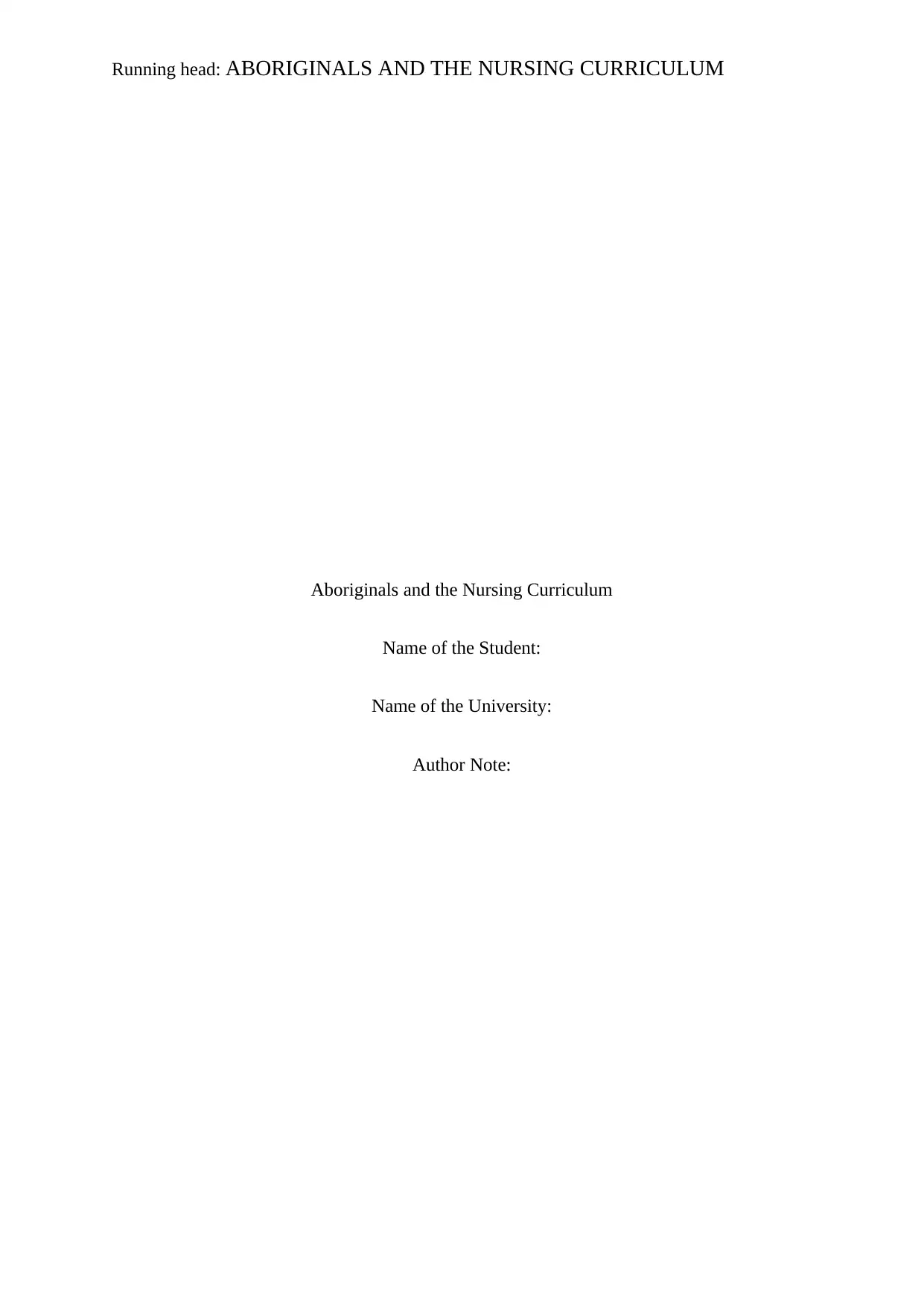
Running head: ABORIGINALS AND THE NURSING CURRICULUM
Aboriginals and the Nursing Curriculum
Name of the Student:
Name of the University:
Author Note:
Aboriginals and the Nursing Curriculum
Name of the Student:
Name of the University:
Author Note:
Paraphrase This Document
Need a fresh take? Get an instant paraphrase of this document with our AI Paraphraser
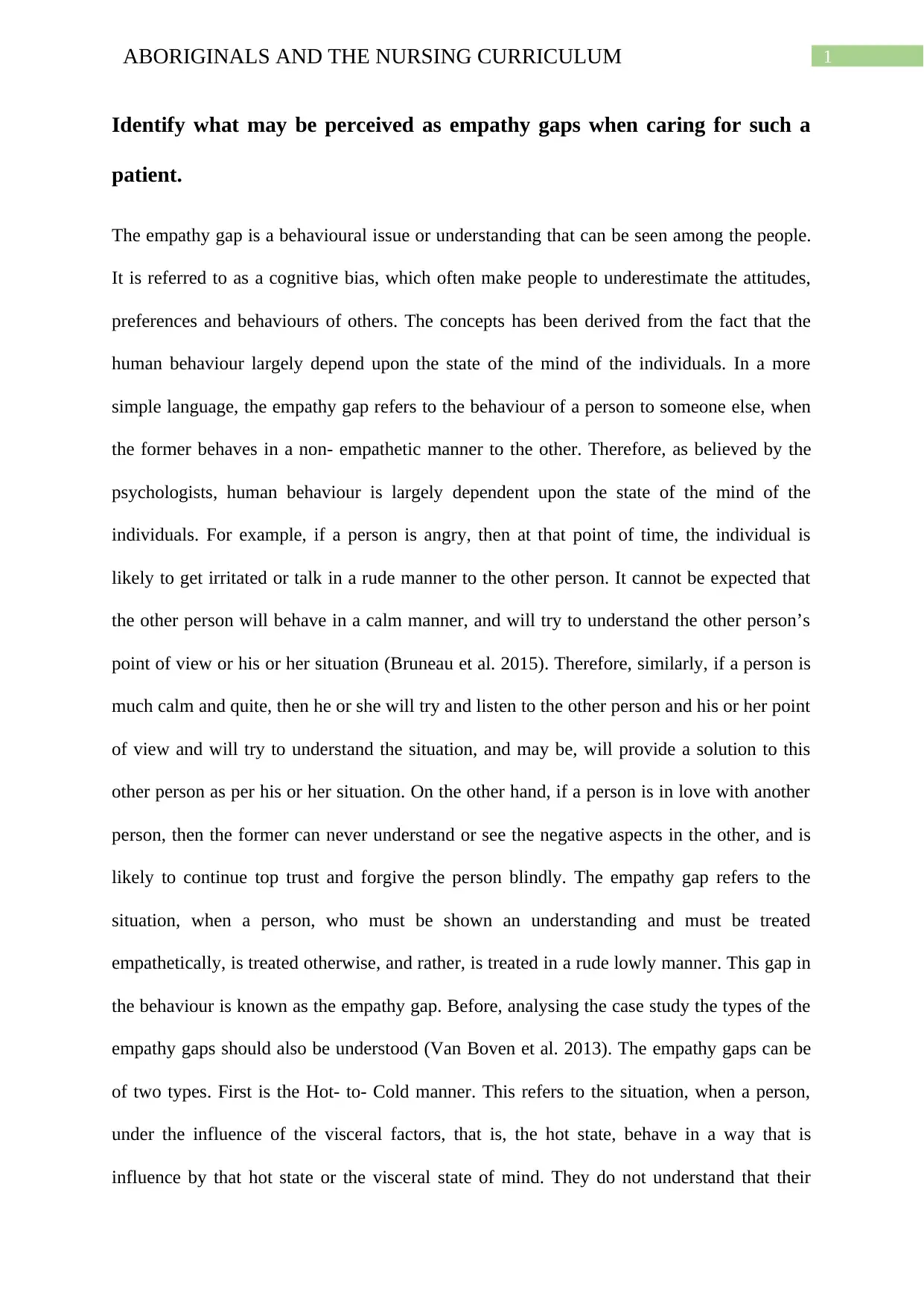
1ABORIGINALS AND THE NURSING CURRICULUM
Identify what may be perceived as empathy gaps when caring for such a
patient.
The empathy gap is a behavioural issue or understanding that can be seen among the people.
It is referred to as a cognitive bias, which often make people to underestimate the attitudes,
preferences and behaviours of others. The concepts has been derived from the fact that the
human behaviour largely depend upon the state of the mind of the individuals. In a more
simple language, the empathy gap refers to the behaviour of a person to someone else, when
the former behaves in a non- empathetic manner to the other. Therefore, as believed by the
psychologists, human behaviour is largely dependent upon the state of the mind of the
individuals. For example, if a person is angry, then at that point of time, the individual is
likely to get irritated or talk in a rude manner to the other person. It cannot be expected that
the other person will behave in a calm manner, and will try to understand the other person’s
point of view or his or her situation (Bruneau et al. 2015). Therefore, similarly, if a person is
much calm and quite, then he or she will try and listen to the other person and his or her point
of view and will try to understand the situation, and may be, will provide a solution to this
other person as per his or her situation. On the other hand, if a person is in love with another
person, then the former can never understand or see the negative aspects in the other, and is
likely to continue top trust and forgive the person blindly. The empathy gap refers to the
situation, when a person, who must be shown an understanding and must be treated
empathetically, is treated otherwise, and rather, is treated in a rude lowly manner. This gap in
the behaviour is known as the empathy gap. Before, analysing the case study the types of the
empathy gaps should also be understood (Van Boven et al. 2013). The empathy gaps can be
of two types. First is the Hot- to- Cold manner. This refers to the situation, when a person,
under the influence of the visceral factors, that is, the hot state, behave in a way that is
influence by that hot state or the visceral state of mind. They do not understand that their
Identify what may be perceived as empathy gaps when caring for such a
patient.
The empathy gap is a behavioural issue or understanding that can be seen among the people.
It is referred to as a cognitive bias, which often make people to underestimate the attitudes,
preferences and behaviours of others. The concepts has been derived from the fact that the
human behaviour largely depend upon the state of the mind of the individuals. In a more
simple language, the empathy gap refers to the behaviour of a person to someone else, when
the former behaves in a non- empathetic manner to the other. Therefore, as believed by the
psychologists, human behaviour is largely dependent upon the state of the mind of the
individuals. For example, if a person is angry, then at that point of time, the individual is
likely to get irritated or talk in a rude manner to the other person. It cannot be expected that
the other person will behave in a calm manner, and will try to understand the other person’s
point of view or his or her situation (Bruneau et al. 2015). Therefore, similarly, if a person is
much calm and quite, then he or she will try and listen to the other person and his or her point
of view and will try to understand the situation, and may be, will provide a solution to this
other person as per his or her situation. On the other hand, if a person is in love with another
person, then the former can never understand or see the negative aspects in the other, and is
likely to continue top trust and forgive the person blindly. The empathy gap refers to the
situation, when a person, who must be shown an understanding and must be treated
empathetically, is treated otherwise, and rather, is treated in a rude lowly manner. This gap in
the behaviour is known as the empathy gap. Before, analysing the case study the types of the
empathy gaps should also be understood (Van Boven et al. 2013). The empathy gaps can be
of two types. First is the Hot- to- Cold manner. This refers to the situation, when a person,
under the influence of the visceral factors, that is, the hot state, behave in a way that is
influence by that hot state or the visceral state of mind. They do not understand that their
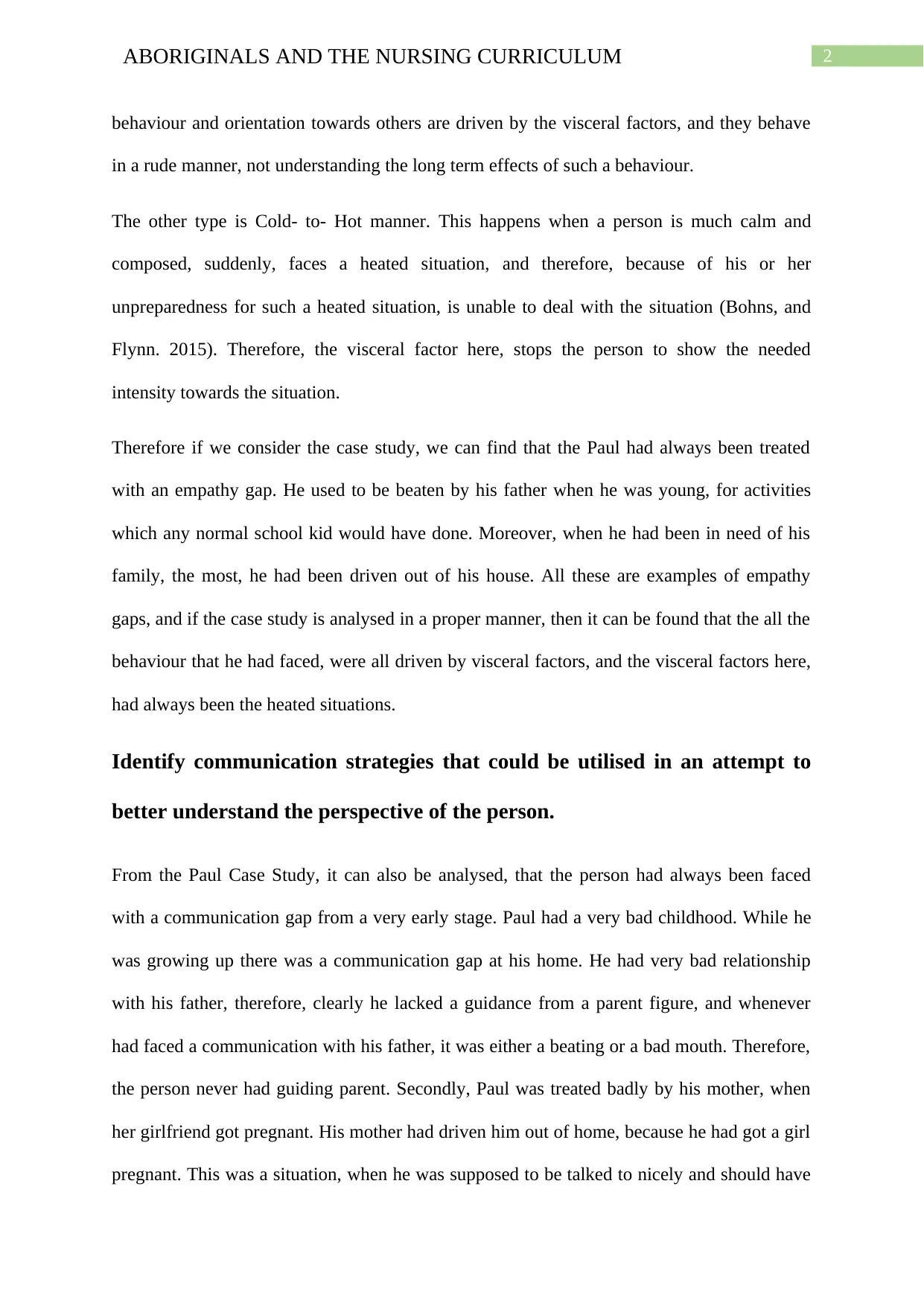
2ABORIGINALS AND THE NURSING CURRICULUM
behaviour and orientation towards others are driven by the visceral factors, and they behave
in a rude manner, not understanding the long term effects of such a behaviour.
The other type is Cold- to- Hot manner. This happens when a person is much calm and
composed, suddenly, faces a heated situation, and therefore, because of his or her
unpreparedness for such a heated situation, is unable to deal with the situation (Bohns, and
Flynn. 2015). Therefore, the visceral factor here, stops the person to show the needed
intensity towards the situation.
Therefore if we consider the case study, we can find that the Paul had always been treated
with an empathy gap. He used to be beaten by his father when he was young, for activities
which any normal school kid would have done. Moreover, when he had been in need of his
family, the most, he had been driven out of his house. All these are examples of empathy
gaps, and if the case study is analysed in a proper manner, then it can be found that the all the
behaviour that he had faced, were all driven by visceral factors, and the visceral factors here,
had always been the heated situations.
Identify communication strategies that could be utilised in an attempt to
better understand the perspective of the person.
From the Paul Case Study, it can also be analysed, that the person had always been faced
with a communication gap from a very early stage. Paul had a very bad childhood. While he
was growing up there was a communication gap at his home. He had very bad relationship
with his father, therefore, clearly he lacked a guidance from a parent figure, and whenever
had faced a communication with his father, it was either a beating or a bad mouth. Therefore,
the person never had guiding parent. Secondly, Paul was treated badly by his mother, when
her girlfriend got pregnant. His mother had driven him out of home, because he had got a girl
pregnant. This was a situation, when he was supposed to be talked to nicely and should have
behaviour and orientation towards others are driven by the visceral factors, and they behave
in a rude manner, not understanding the long term effects of such a behaviour.
The other type is Cold- to- Hot manner. This happens when a person is much calm and
composed, suddenly, faces a heated situation, and therefore, because of his or her
unpreparedness for such a heated situation, is unable to deal with the situation (Bohns, and
Flynn. 2015). Therefore, the visceral factor here, stops the person to show the needed
intensity towards the situation.
Therefore if we consider the case study, we can find that the Paul had always been treated
with an empathy gap. He used to be beaten by his father when he was young, for activities
which any normal school kid would have done. Moreover, when he had been in need of his
family, the most, he had been driven out of his house. All these are examples of empathy
gaps, and if the case study is analysed in a proper manner, then it can be found that the all the
behaviour that he had faced, were all driven by visceral factors, and the visceral factors here,
had always been the heated situations.
Identify communication strategies that could be utilised in an attempt to
better understand the perspective of the person.
From the Paul Case Study, it can also be analysed, that the person had always been faced
with a communication gap from a very early stage. Paul had a very bad childhood. While he
was growing up there was a communication gap at his home. He had very bad relationship
with his father, therefore, clearly he lacked a guidance from a parent figure, and whenever
had faced a communication with his father, it was either a beating or a bad mouth. Therefore,
the person never had guiding parent. Secondly, Paul was treated badly by his mother, when
her girlfriend got pregnant. His mother had driven him out of home, because he had got a girl
pregnant. This was a situation, when he was supposed to be talked to nicely and should have
⊘ This is a preview!⊘
Do you want full access?
Subscribe today to unlock all pages.

Trusted by 1+ million students worldwide
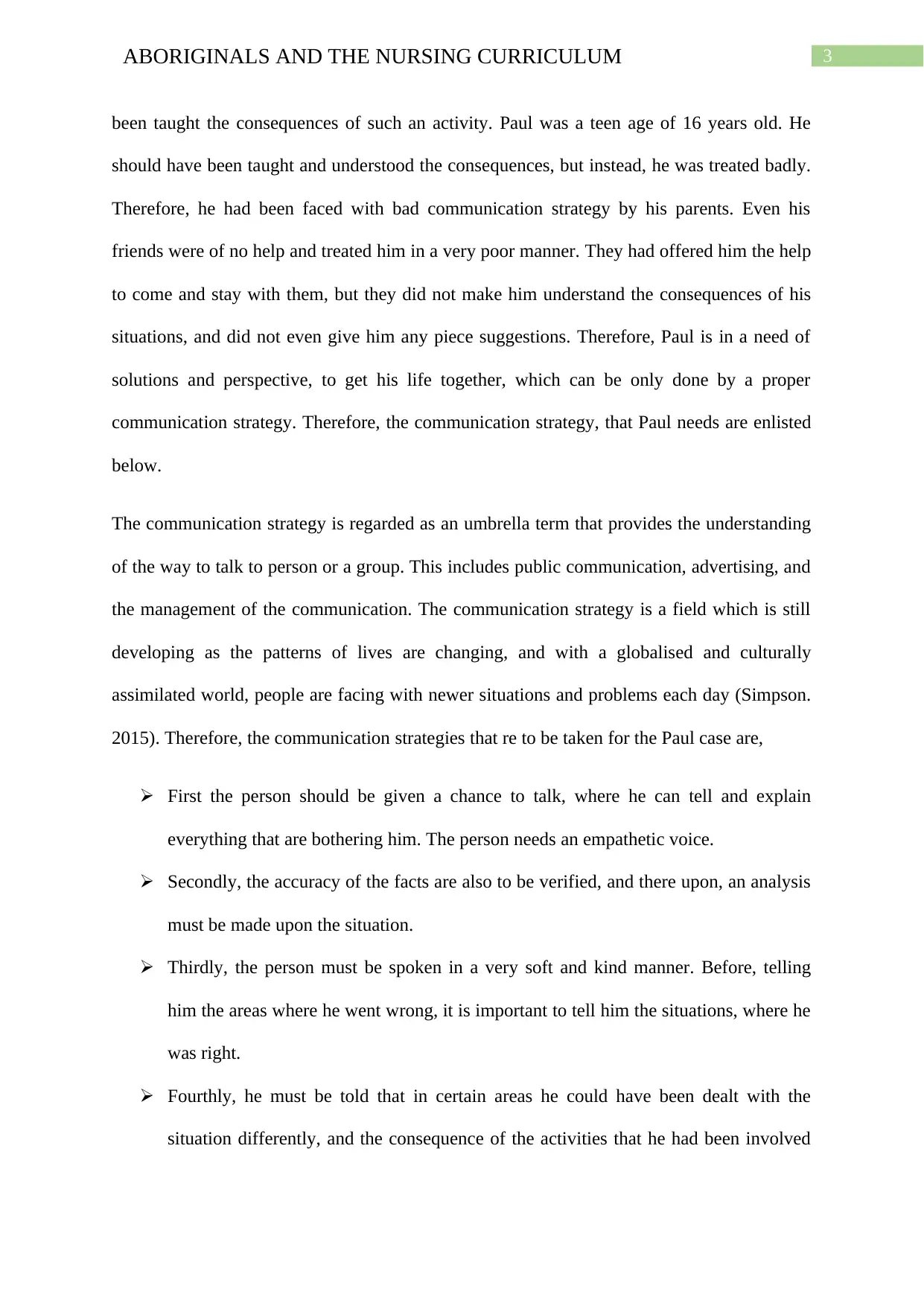
3ABORIGINALS AND THE NURSING CURRICULUM
been taught the consequences of such an activity. Paul was a teen age of 16 years old. He
should have been taught and understood the consequences, but instead, he was treated badly.
Therefore, he had been faced with bad communication strategy by his parents. Even his
friends were of no help and treated him in a very poor manner. They had offered him the help
to come and stay with them, but they did not make him understand the consequences of his
situations, and did not even give him any piece suggestions. Therefore, Paul is in a need of
solutions and perspective, to get his life together, which can be only done by a proper
communication strategy. Therefore, the communication strategy, that Paul needs are enlisted
below.
The communication strategy is regarded as an umbrella term that provides the understanding
of the way to talk to person or a group. This includes public communication, advertising, and
the management of the communication. The communication strategy is a field which is still
developing as the patterns of lives are changing, and with a globalised and culturally
assimilated world, people are facing with newer situations and problems each day (Simpson.
2015). Therefore, the communication strategies that re to be taken for the Paul case are,
First the person should be given a chance to talk, where he can tell and explain
everything that are bothering him. The person needs an empathetic voice.
Secondly, the accuracy of the facts are also to be verified, and there upon, an analysis
must be made upon the situation.
Thirdly, the person must be spoken in a very soft and kind manner. Before, telling
him the areas where he went wrong, it is important to tell him the situations, where he
was right.
Fourthly, he must be told that in certain areas he could have been dealt with the
situation differently, and the consequence of the activities that he had been involved
been taught the consequences of such an activity. Paul was a teen age of 16 years old. He
should have been taught and understood the consequences, but instead, he was treated badly.
Therefore, he had been faced with bad communication strategy by his parents. Even his
friends were of no help and treated him in a very poor manner. They had offered him the help
to come and stay with them, but they did not make him understand the consequences of his
situations, and did not even give him any piece suggestions. Therefore, Paul is in a need of
solutions and perspective, to get his life together, which can be only done by a proper
communication strategy. Therefore, the communication strategy, that Paul needs are enlisted
below.
The communication strategy is regarded as an umbrella term that provides the understanding
of the way to talk to person or a group. This includes public communication, advertising, and
the management of the communication. The communication strategy is a field which is still
developing as the patterns of lives are changing, and with a globalised and culturally
assimilated world, people are facing with newer situations and problems each day (Simpson.
2015). Therefore, the communication strategies that re to be taken for the Paul case are,
First the person should be given a chance to talk, where he can tell and explain
everything that are bothering him. The person needs an empathetic voice.
Secondly, the accuracy of the facts are also to be verified, and there upon, an analysis
must be made upon the situation.
Thirdly, the person must be spoken in a very soft and kind manner. Before, telling
him the areas where he went wrong, it is important to tell him the situations, where he
was right.
Fourthly, he must be told that in certain areas he could have been dealt with the
situation differently, and the consequence of the activities that he had been involved
Paraphrase This Document
Need a fresh take? Get an instant paraphrase of this document with our AI Paraphraser
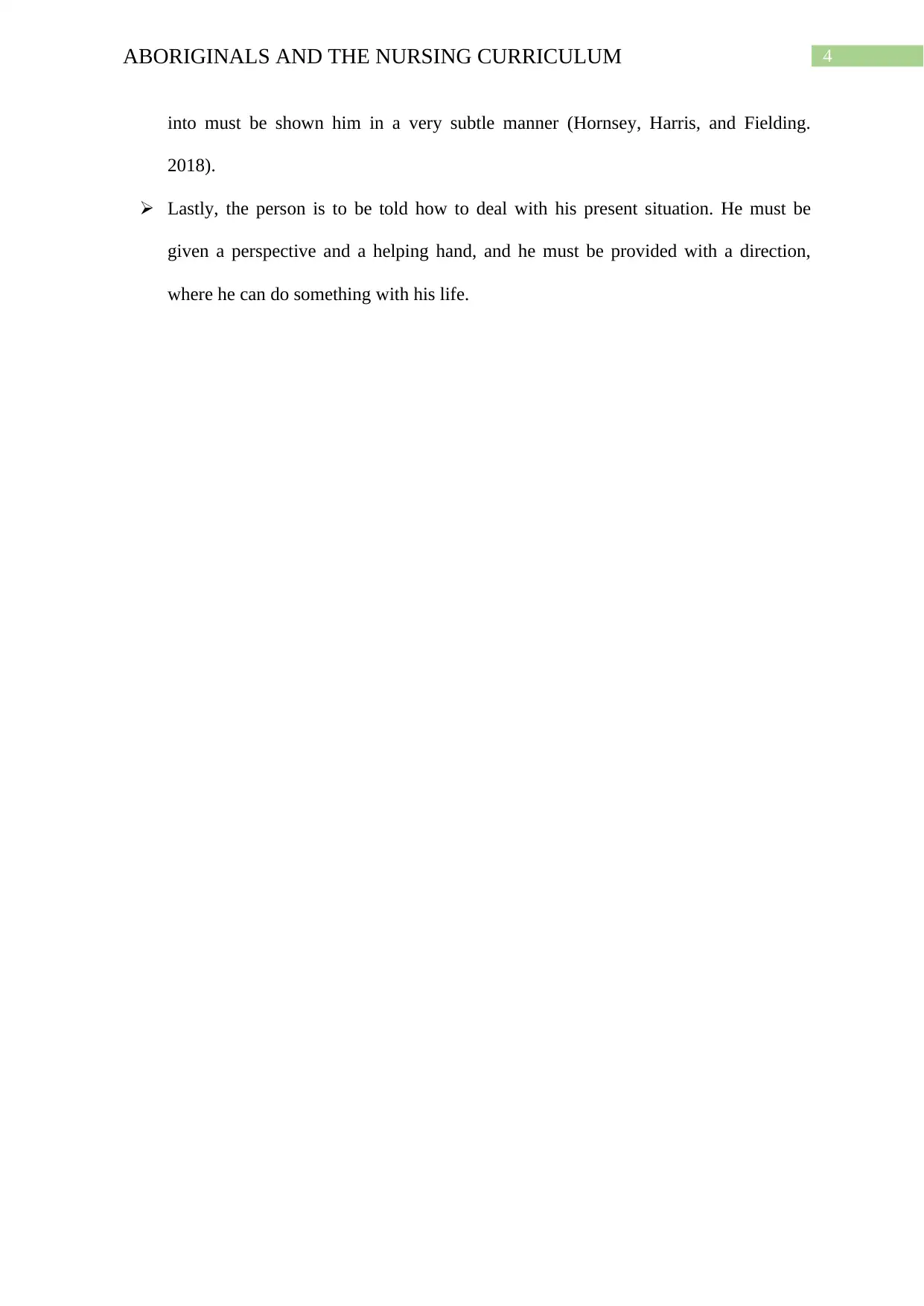
4ABORIGINALS AND THE NURSING CURRICULUM
into must be shown him in a very subtle manner (Hornsey, Harris, and Fielding.
2018).
Lastly, the person is to be told how to deal with his present situation. He must be
given a perspective and a helping hand, and he must be provided with a direction,
where he can do something with his life.
into must be shown him in a very subtle manner (Hornsey, Harris, and Fielding.
2018).
Lastly, the person is to be told how to deal with his present situation. He must be
given a perspective and a helping hand, and he must be provided with a direction,
where he can do something with his life.
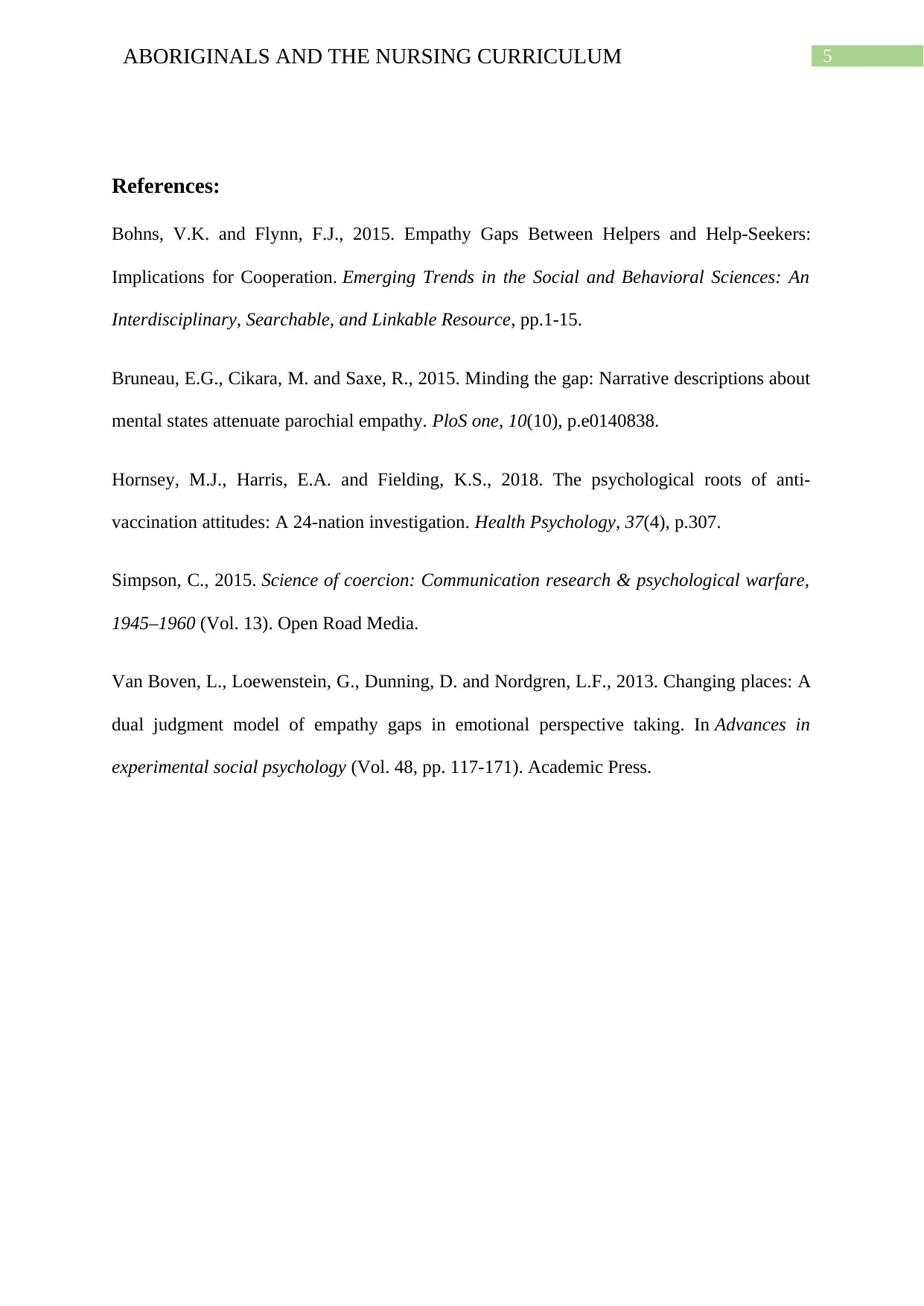
5ABORIGINALS AND THE NURSING CURRICULUM
References:
Bohns, V.K. and Flynn, F.J., 2015. Empathy Gaps Between Helpers and Help‐Seekers:
Implications for Cooperation. Emerging Trends in the Social and Behavioral Sciences: An
Interdisciplinary, Searchable, and Linkable Resource, pp.1-15.
Bruneau, E.G., Cikara, M. and Saxe, R., 2015. Minding the gap: Narrative descriptions about
mental states attenuate parochial empathy. PloS one, 10(10), p.e0140838.
Hornsey, M.J., Harris, E.A. and Fielding, K.S., 2018. The psychological roots of anti-
vaccination attitudes: A 24-nation investigation. Health Psychology, 37(4), p.307.
Simpson, C., 2015. Science of coercion: Communication research & psychological warfare,
1945–1960 (Vol. 13). Open Road Media.
Van Boven, L., Loewenstein, G., Dunning, D. and Nordgren, L.F., 2013. Changing places: A
dual judgment model of empathy gaps in emotional perspective taking. In Advances in
experimental social psychology (Vol. 48, pp. 117-171). Academic Press.
References:
Bohns, V.K. and Flynn, F.J., 2015. Empathy Gaps Between Helpers and Help‐Seekers:
Implications for Cooperation. Emerging Trends in the Social and Behavioral Sciences: An
Interdisciplinary, Searchable, and Linkable Resource, pp.1-15.
Bruneau, E.G., Cikara, M. and Saxe, R., 2015. Minding the gap: Narrative descriptions about
mental states attenuate parochial empathy. PloS one, 10(10), p.e0140838.
Hornsey, M.J., Harris, E.A. and Fielding, K.S., 2018. The psychological roots of anti-
vaccination attitudes: A 24-nation investigation. Health Psychology, 37(4), p.307.
Simpson, C., 2015. Science of coercion: Communication research & psychological warfare,
1945–1960 (Vol. 13). Open Road Media.
Van Boven, L., Loewenstein, G., Dunning, D. and Nordgren, L.F., 2013. Changing places: A
dual judgment model of empathy gaps in emotional perspective taking. In Advances in
experimental social psychology (Vol. 48, pp. 117-171). Academic Press.
⊘ This is a preview!⊘
Do you want full access?
Subscribe today to unlock all pages.

Trusted by 1+ million students worldwide
1 out of 6
Related Documents
Your All-in-One AI-Powered Toolkit for Academic Success.
+13062052269
info@desklib.com
Available 24*7 on WhatsApp / Email
![[object Object]](/_next/static/media/star-bottom.7253800d.svg)
Unlock your academic potential
Copyright © 2020–2025 A2Z Services. All Rights Reserved. Developed and managed by ZUCOL.





